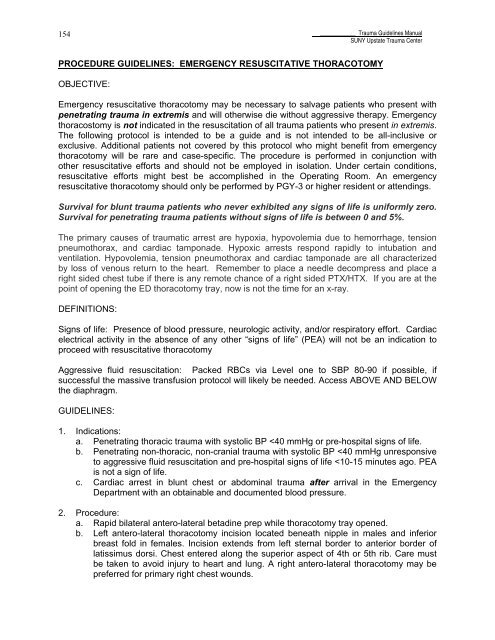Trauma Guideline Manual - SUNY Upstate Medical University
Trauma Guideline Manual - SUNY Upstate Medical University
Trauma Guideline Manual - SUNY Upstate Medical University
Create successful ePaper yourself
Turn your PDF publications into a flip-book with our unique Google optimized e-Paper software.
154____________ <strong>Trauma</strong> <strong>Guideline</strong>s <strong>Manual</strong><strong>SUNY</strong> <strong>Upstate</strong> <strong>Trauma</strong> CenterPROCEDURE GUIDELINES: EMERGENCY RESUSCITATIVE THORACOTOMYOBJECTIVE:Emergency resuscitative thoracotomy may be necessary to salvage patients who present withpenetrating trauma in extremis and will otherwise die without aggressive therapy. Emergencythoracostomy is not indicated in the resuscitation of all trauma patients who present in extremis.The following protocol is intended to be a guide and is not intended to be all-inclusive orexclusive. Additional patients not covered by this protocol who might benefit from emergencythoracotomy will be rare and case-specific. The procedure is performed in conjunction withother resuscitative efforts and should not be employed in isolation. Under certain conditions,resuscitative efforts might best be accomplished in the Operating Room. An emergencyresuscitative thoracotomy should only be performed by PGY-3 or higher resident or attendings.Survival for blunt trauma patients who never exhibited any signs of life is uniformly zero.Survival for penetrating trauma patients without signs of life is between 0 and 5%.The primary causes of traumatic arrest are hypoxia, hypovolemia due to hemorrhage, tensionpneumothorax, and cardiac tamponade. Hypoxic arrests respond rapidly to intubation andventilation. Hypovolemia, tension pneumothorax and cardiac tamponade are all characterizedby loss of venous return to the heart. Remember to place a needle decompress and place aright sided chest tube if there is any remote chance of a right sided PTX/HTX. If you are at thepoint of opening the ED thoracotomy tray, now is not the time for an x-ray.DEFINITIONS:Signs of life: Presence of blood pressure, neurologic activity, and/or respiratory effort. Cardiacelectrical activity in the absence of any other “signs of life” (PEA) will not be an indication toproceed with resuscitative thoracotomyAggressive fluid resuscitation: Packed RBCs via Level one to SBP 80-90 if possible, ifsuccessful the massive transfusion protocol will likely be needed. Access ABOVE AND BELOWthe diaphragm.GUIDELINES:1. Indications:a. Penetrating thoracic trauma with systolic BP
















